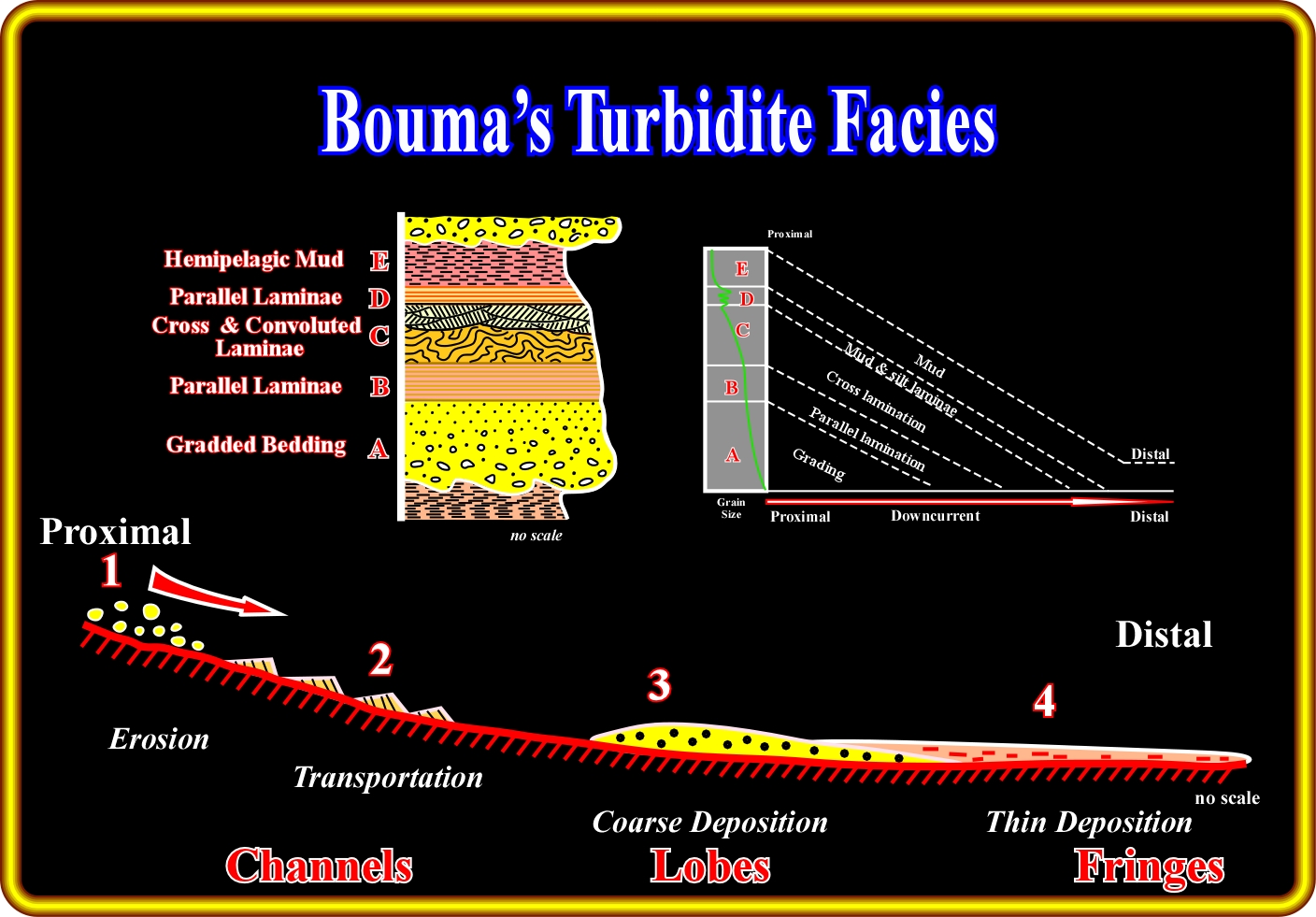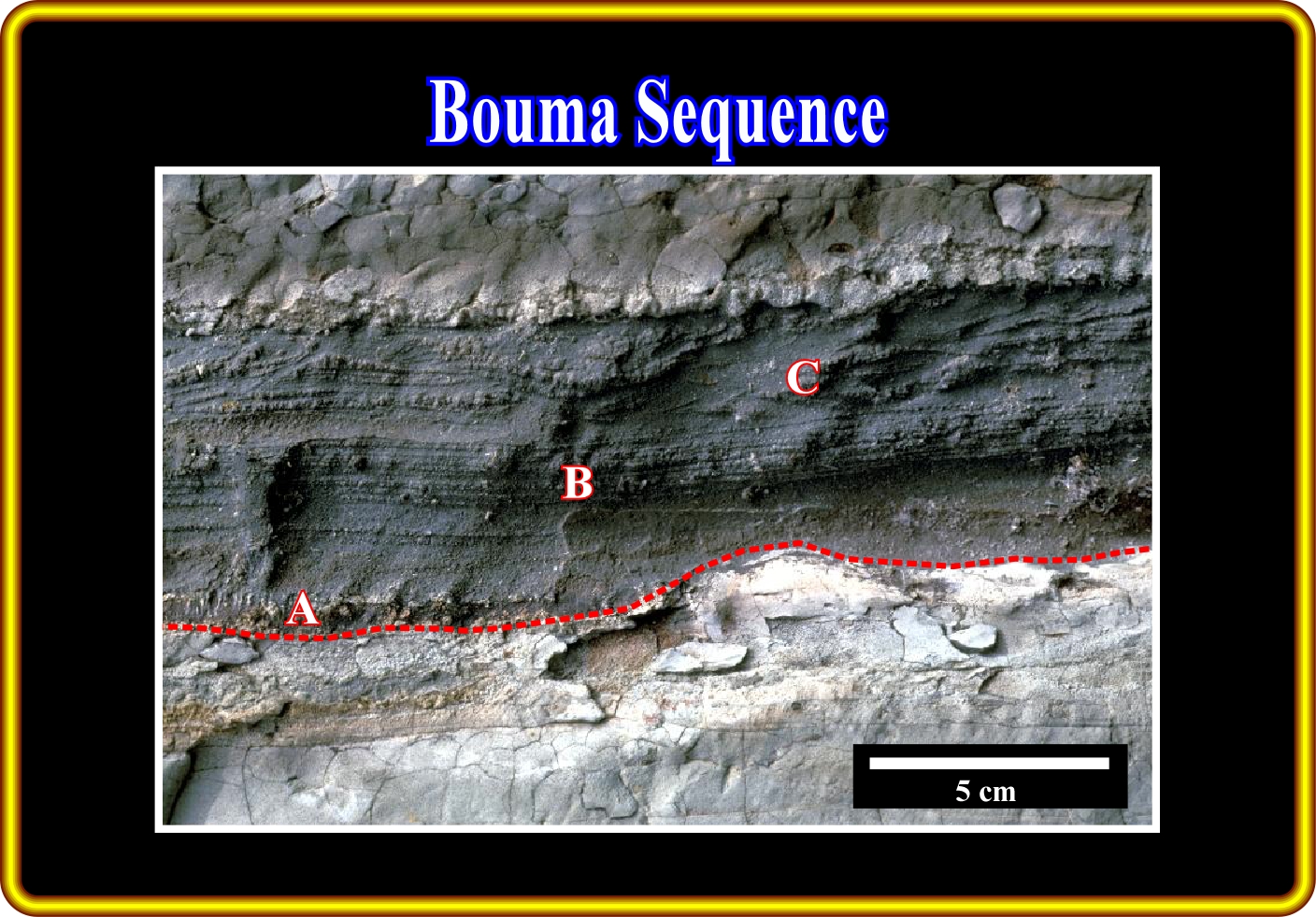
VI) - Turbidite Facies and Related Processes
A turbidite facies tract (FT) was defined by Mutti (1977, 1992) as :
" The lateral association of genetic facies that can be observed within an individual bed or a package of strictly time-equivalent beds"
Although facies tracts develop both in crosscurrent and along-current directions, lateral facies tracts refer primarily to facies changes that are observed in a direction parallel to the flow. The recognition of facies tracts suffers from two main limitations:
(i) The first is related to the fact that facies tracts can only be established within precise time-correlation patterns, i.e., within thin stratigraphic units that are physically traceable over significant areas.
(ii) The second limitation is represented by the very low-gradient facies variations that most systems undergo over the available outcrop areas.
In terms of facies, Walker (1984) considered a set of sedimentary features characterizing the classical turbidite deposits, as follows :
1- Sandstones and shales are monotonously interbedded through many tens or hundred of meters of stratigraphic sections. Beds tend to have flat tops and bottoms, with no scouring and channelling on a scale greater than a few centimetres ;
2) Sandstones beds have sharp, abrupt bases, and tend to grade upward into finer sand, silt and mud. Much of the mud was brought into the basin by the turbidite current (it contains a shallow water transported faunal assemblage), but the uppermost very fine clay may contain a bathyal or abyssal benthonic fauna and hence represent slow hemipelagic deposition between turbidity current events.
3) On the undersurface (sole) of the sandstone beds there are abundant markings, now classified into three types :
(i) Tool marks carved into the underlying mud by rigid objects /sticks, stones) in the turbidite current ;
(ii) Scour marks cut into the underlying muds by fluid scour and
(iii) Organic markings representing trails and burrows filled by the turbidite current.
Tool and scour marks give accurate indications of local paleoflow directions, and by now, many thousands have been measured to reconstruct paleoflow patterns in hundreds of turbidite basins.
4) Within the sandstone beds, combinations of parallel lamination, ripple cross lamination, climbing ripple cross lamination, convolute lamination and graded bedding have been noted by many authors.
An ideal or generalized succession (or sequence) of facies was proposed by Bouma (1962). The Bouma sequence, illustrated below, can be regarded as an excellent facies model for classical turbidites, that is to say, those which consist of monotonous alternations of sandstones and shales, parallel bedded without significant scouring or channelling and where all the beds can reasonably be described using the Bouma sequence. This classical model seems to fit better with those gravity flows associated with significant relative sea level falls (Vail's model). However, as said previously, geoscientists should not forget that Vail's model is main used at large scale, in petroleum exploration, particularly, on the seismic lines. Subsequently, all this facies and geological marks are only recognized in the Mutti's model, which is mainly used on the field (scale 1:1), subsurface (electrical logs and cores), and, sometimes. in particular cases in 3D seismic lines shot to develop certain oil fields, as we will see later.

In a complete Bouma sequence, five divisions can be considered : A) Massive or graded bedding interval ; B) Sandy parallel laminations ; C) Rippled and /or convoluted ; D) Delicate parallel interlaminations of silt and mud and E) Mud introduced by the turbidity current and hemipelagic background mud of the basin. As illustrated, in the lower part of the figure, the organization of a turbidite sequence facies changes with its position in the fan and so with the velocity of the current. Updip, facies A are those of debris flows ; Facies B, quite rich in sand like those of traction currents ; Facies C is the classic turbidite with a complete Bouma sequence (a-b-c-d-e) ; Facies D, rich in ,thin beds, quite developed bottom-truncated Bouma sequence (b-c-d-e, c-d-e or d-e). In the fringes (lower fans), the sediments are thin. They are, often reworked by sea floor current, which following continent contours are called contour currents. The reworked sediments exhibit current ripples and forms, and are called contourites by geoscientists.

A complete Bouma sequence, as illustrated in the previous plate, begins with a graded division A, which is overlain by parallel laminated division B and cross-laminated division C. In this example, the facies D and E are very thin, almost invisible, due to erosion or non-deposition. As said previously, bottom sea currents, erode, often, the upper divisions, since turbidite currents can erode the substratum on which they flow. The erosion depend mainly on the density of the current and the type of sediments that it transport.
On a small scale, the Bouma sequence works quite well as a facies model for classical turbidites. However, as pointed out by Walker (1984) there are other turbidite facies that are not characterized by Bouma sequences, as (i) massive sandstones, (ii) pebbly sandstones, (iii) conglomerates and (iv) slumps, slides, debris flows and other exotic facies.
It is interesting to notice that the turbidite system was the first in which a universal facies scheme was proposed by Mutti and Ricci Luchi (1972). The Mutti and Ricci Luchi scheme has been modified over the years.

This plate illustrates the fan model of Mutti and Ricci Luchi, in which (U) is the upper continental slope, (L) the lower continental slope, (IF) is the inner fan, (MF) the middle fan and (OF) the outer fan. The log, on the left, represents a hypothetical sequence formed during a fan progradation, in which a "positive" facies sequence, that is to say, a coarsening and thickening upward interval and negative, i.e., a thinning and fining upward interval. It is important to note that the limits between the outer, middle and inner fan do not correspond to unconformities. Only the basal limit between the basin plain and the outer fan corresponds to an erosional surface (unconformity), as well as the limit between different fan complexes. This turbidite model strongly suggest that the turbidite currents are induced by slope and flush floods, in highstand geological conditions, rather than by relative sea level falls inducing lowstand geological conditions.